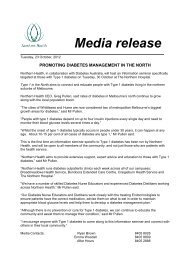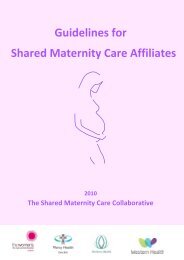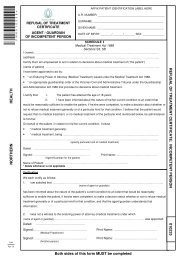Research Week Abstract Book - Northern Health
Research Week Abstract Book - Northern Health
Research Week Abstract Book - Northern Health
Create successful ePaper yourself
Turn your PDF publications into a flip-book with our unique Google optimized e-Paper software.
Aged Care<br />
Aged Care<br />
A COMParison OF OUTCOMES ASSOCIATED WITH ADDinG A HOMEbaseD<br />
EXERCise ProGRAM (heP) TO A GrouP EXERCise ProGRAM<br />
(GEP) FOR ClienTS ATTENDinG COMMUNITY THERAPY SERVICes (CTS) AT<br />
broaDmeaDOWS HEALTH SERVICE (bhs).<br />
Whitbourne C, Koh KWZ, Lawler K, Cooke S, Terkely R, Hill K.<br />
Background<br />
Many clients referred to BHS have balance impairments, are vulnerable to falling and serious injuries. Evidence indicates that<br />
at least 50 hours of exercise is required for lasting changes to balance and reduce falls risk.<br />
Aim<br />
To analyse if the addition of HEP improves balance outcomes more than a GEP in isolation (usual care) for patients with<br />
balance impairments.<br />
Methodology<br />
Twenty-three participants with similar baseline characteristics (p>0.05) were recruited prospectively for our randomisedcontrolled<br />
trial with concealed allocation and assessor blinding. Usual care included a 6-8 week GEP (one hour weekly). The<br />
intervention group also completed 2 home-based physiotherapy sessions to tailor a HEP for clients to complete daily and<br />
record in a diary until 3 month follow-up. Outcome measures included the Balance Outcome Measure for Elder Rehabilitation<br />
(BOOMER) and force platform measures using the Neurocom Balance Master, taken pre, post and 3 months.<br />
Results<br />
Currently eighteen participants have completed post-group analysis, sixteen have completed 3 month follow-up. After<br />
8-weeks both groups showed statistically significant gains on BOOMER (n=14 p=0.016, n=9 p=0.011 for control and<br />
intervention groups respectively) and were similar at 3 months. At 3 months, the only statistically significant differences<br />
between groups were Neurocom limits of stability reaction time on right (n=15, p=0.009), left (n=15, p=0.011) and<br />
composite scores (n=13, p=0.008) all in favour of the experimental group.<br />
Conclusion<br />
The addition of HEP to GEP is similar to a GEP in isolation (usual care). Recruitment of further participants will add to this<br />
studies power. Further studies may identify the long-term benefits for clients with balance impairments.<br />
13

















